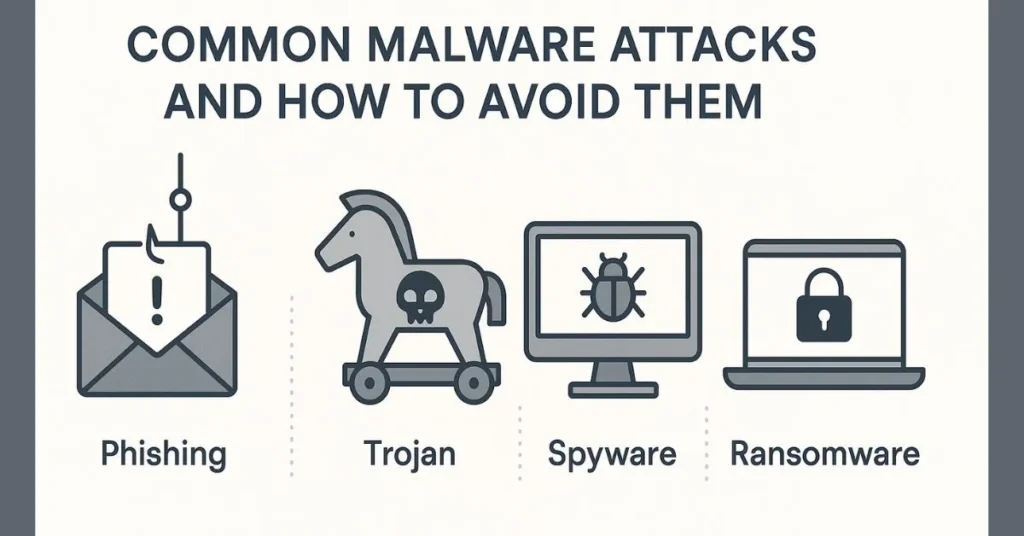Contents
Introduction
In 2025, malware attacks have reached unprecedented levels, affecting not only large corporations but also small businesses, government agencies, and individual users. Cybercriminals are leveraging advanced tactics such as artificial intelligence, automation, and sophisticated evasion techniques to bypass traditional defenses.
The financial impact is staggering, with global ransomware losses alone projected to surpass billions of dollars this year. Malware no longer limits itself to causing technical disruptions-it can steal sensitive data, disrupt essential services, and even endanger public safety.
Understanding how malware operates, the types of attacks that are most common, and the best prevention strategies is crucial for reducing risk in today’s digital environment.
Understanding Malware and Its Purpose
Malware-short for malicious software any program or code designed to harm a computer, server, network, or device. Unlike legitimate software, malware is created with malicious intent, aiming to compromise data, disrupt operations, or gain unauthorized access to systems.
Cybercriminals create malware for various purposes:
Theft – Stealing financial information, login credentials, or intellectual property.
Disruption – Causing downtime or interfering with operations.
Espionage – Gathering confidential information for competitive or political gain.
Sabotage – Damaging critical infrastructure or systems.
While hacking refers to gaining unauthorized access and phishing focuses on tricking users into revealing sensitive information, malware is the malicious payload that executes harmful actions once delivered.
How Malware Spreads Across Devices and Networks
Malware has multiple pathways to infiltrate systems:
- Email and messaging platforms – Malicious attachments or links are sent directly to users.
- Compromised USB drives and removable media – Infected devices spread malware when connected to another system.
- Exploiting unpatched vulnerabilities – Cybercriminals take advantage of outdated operating systems or software to gain entry.
For businesses, implementing steps to prevent malware attacks on business networks is essential to mitigate these risks. Solutions like network segmentation, advanced endpoint protection, and employee awareness training can drastically reduce exposure.
Additional insights on enterprise cybersecurity approaches can be found in resources from the Cybersecurity & Infrastructure Security Agency (CISA), which provides actionable security guidelines for organizations.
Most Common Types of Malware Attacks
Ransomware Attacks
Ransomware encrypts a victim’s files, rendering them inaccessible until a ransom is paid-often in cryptocurrency. Notable incidents like the WannaCry outbreak crippled hospitals and businesses worldwide, proving ransomware’s destructive potential.
Phishing and Malicious Email Attachments
Cybercriminals use deceptive emails to lure victims into clicking harmful links or opening infected attachments. These emails often mimic legitimate senders, making them hard to detect.
Drive-by Downloads and Malicious Websites
Drive-by downloads occur when malware is installed automatically upon visiting a compromised site. Malvertising, or malicious advertising, uses legitimate ad networks to deliver infected ads that redirect users to harmful sites.
Trojans Disguised as Legitimate Software
Trojans pose as useful software but secretly create backdoors for attackers. This method is common in pirated applications and fake system utilities.
Worms and Network Propagation
Worms self-replicate and spread across networks without user interaction. They can infect hundreds of systems in minutes, making them a favorite for large-scale cyberattacks.
Spyware and Keyloggers
Spyware monitors user activities and steals sensitive information, while keyloggers record keystrokes to capture passwords and financial data.
Warning Signs of a Malware Infection
Detecting malware early can minimize damage. Warning signs include:
- Slow performance and frequent crashes – Malware often consumes system resources.
- Unexpected pop-ups and altered settings – These can indicate spyware or adware activity.
- Disabled security software – Malware may disable antivirus tools to avoid detection.
- Unusual network activity – High data usage could mean data is being stolen.
Strategies to Avoid Common Malware Attacks
Use Trusted Security Software
Invest in reputable antivirus, anti-malware, and endpoint protection tools. Ensure real-time scanning is enabled, and schedule regular system scans.
Keep Systems and Applications Updated
Patch vulnerabilities promptly through automatic updates to prevent attackers from exploiting known flaws.
Practice Safe Browsing and Email Habits
Verify links and attachments before clicking. Use tools like Google Safe Browsing to check site safety before visiting unfamiliar domains.
Apply Strong Access Controls
Enforce multi-factor authentication (MFA) and limit administrative privileges to essential personnel.
Regular Data Backups
Maintain encrypted, offline backups. This ensures ransomware attacks can’t permanently destroy your data.
The National Institute of Standards and Technology also provides cybersecurity best practices that organizations can adopt to strengthen malware defenses.
The Role of Employee and User Awareness
Technology alone isn’t enough-humans remain the weakest link in cybersecurity. Regular training sessions can teach employees to spot suspicious emails, avoid unsafe downloads, and report anomalies quickly. Creating a security-first culture helps ensure everyone plays a role in protecting systems.
Emerging Threats and Future Trends in Malware
AI-driven malware – Adapts to avoid detection.
Fileless malware – Operates entirely in memory, leaving fewer traces.
IoT-based attacks – Targets smart devices, often with minimal built-in security.
Security experts recommend following updates from the European Union Agency for Cybersecurity (ENISA) to stay informed about new threats and mitigation strategies.
Conclusion
Malware continues to be one of the most significant cybersecurity challenges. From ransomware to spyware, attackers are finding increasingly creative ways to compromise systems.
A proactive defense that combines trusted security software, regular updates, safe online habits, and strong access controls is essential. By understanding how malware spreads and taking preventive measures, individuals and organizations can significantly reduce the risk of falling victim to these cyber threats.
FAQs
Q1: What’s the difference between a virus and ransomware?
A virus spreads by infecting files, while ransomware encrypts files and demands payment for their release.
Q2: Can mobile phones get infected with malware?
Yes, smartphones can be infected through malicious apps, phishing links, and compromised websites.
Q3: Is free antivirus software enough to protect against malware?
Free antivirus can offer basic protection, but paid solutions often include advanced features like ransomware protection, firewall integration, and real-time threat intelligence.

